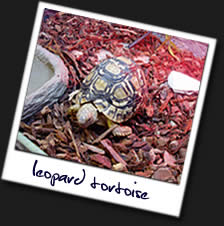www.reptiles-info.co.uk

Leopard Tortoises Healthcare:
Leopard Tortoise's are generally a hardy reptile and will rarely suffer from diseases or illnesses providing they are housed and fed correctly. If however you Tortoise does become ill we have offered a few symptoms that can help to diagnose your leopard tortoise. If any problems persist it is advised that you see you veterinary surgeon immediately.
Metabolic Bone Disease:
The symptoms of metabolic bone disease involve the limbs of your leopard tortoise becoming distorted and twisted this is due to the fact that the tortoise has received a lack of calcium in its diet and in order to gain the calcium needed the leopard tortoise will start to use the calcium in its bones, this leads to the twisted and distorted look of the tortoises limbs. In order to help prevent metabolic bone disease you must regularly add calcium to your leopard tortoise's diet in order to stop the onset of MBD. If it has contracted the disease I would advise you to visit your vet immediately in order to discover if tortoise can be cured.
Shell Rot:
If you notice that your shields on the tortoise's shell have become loose and look infected it is most likely that your tortoise has contracted sheell rot. The best form of treatment for this is to clecn the shell/infected area daily with a mixture of nolvasan which will help to cure the illness. If this process shows no signs of improvment after the first few days i would advise you to consult your veterinary surgeon immediately.
Burns:
Skin damage and the burning of your tortoise's skin can be a common and some times fatal injury to your leopard tortoise that is often caused by bulbs being to close and easily exposed within your tortoise's housing. This can be prevented by making sure your bulb is the correct distance away form the leopard tortoise.
Pneumonia:
This is a common form of respiratory disease within leopard tortoises and can often be fatal if not diagnosed quicky. The symptoms of pneumonia within your tortoise are signs of a constant runny nose, notable weakness in the tortoise, porr mobility of limbs and head and open mouth breathing. Pneumonia is often caused by the environment in which the leopard tortoise is living with examples of damp conditions, incorrect temperatures within the housing and also unhygienic housing. It is advise not to try and treat this illness by yourself and seee the your vet straight away.
Physical Injuries:
Injuries to the skin and body of your tortoise such as scratches, cuts, sores and abrasions can be typical types of captive leopard tortoise injuries. The usual reasons behind this are that they have rubbed against an item within their housing. To prevent this type of injury make sure that all of the items within your tortoises housing have rounded edges with no sharp points that could lead to injury.
Impacted Colon:
This is often due to the leopard tortoise being fed an incorrect diet or it has accidentally eaten the wrong type of food if housed outside. You can spot this disease if your leopard tortoise has become lethargic and has not produced any waste products for a period of time. In order to aid digestion it is advised that you place your tortoise in a bath of warm water to aid the digestion process of the tortoise and visit your vet straight away.
Leopard Tortoise Pages






